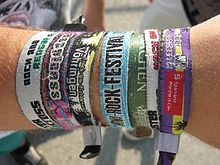
A bracelet is an article of jewellery that is worn around the wrist. Bracelets may serve different uses, such as being worn as an ornament. When worn as ornaments, bracelets may have a supportive function to hold other items of decoration, such as charms. Medical and identity information are marked on some bracelets, such as allergy bracelets, hospital patient-identification tags, and bracelet tags for newborn babies. Bracelets may be worn to signify a certain phenomenon, such as breast cancer awareness, or for religious/cultural purposes.

In urinary catheterization a latex, polyurethane, or silicone tube known as a urinary catheter is inserted into the bladder through the urethra to allow urine to drain from the bladder for collection. It may also be used to inject liquids used for treatment or diagnosis of bladder conditions. A clinician, often a nurse, usually performs the procedure, but self-catheterization is also possible. A catheter may be in place for long periods of time or removed after each use.

Latex allergy is a medical term encompassing a range of allergic reactions to the proteins present in natural rubber latex. It generally develops after repeated exposure to products containing natural rubber latex. When latex-containing medical devices or supplies come in contact with mucous membranes, the membranes may absorb latex proteins. In some susceptible people, the immune system produces antibodies that react immunologically with these antigenic proteins. Many items contain or are made from natural rubber, including shoe soles, pen grips, hot water bottles, elastic bands, rubber gloves, condoms, baby-bottle nipples, and balloons; consequently, there are many possible routes of exposure that may trigger a reaction. People with latex allergies may also have or develop allergic reactions to some fruits, such as bananas.

A medical identification tag is a small emblem or tag worn on a bracelet, neck chain, or on the clothing bearing a message that the wearer has an important medical condition that might require immediate attention. For emergency medical providers such as paramedics and emergency physicians, medical identification tags are particularly useful in situations where the wearer is unconscious, altered mental status, very young, or otherwise unable to provide critical medical information. The tag is often made out of stainless steel or sterling silver. A wallet card with the same information may be used instead of or along with a tag, and a stick-on medical ID tag may be added or used alone.
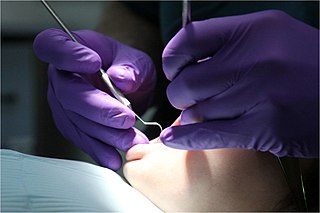
Medical gloves are disposable gloves used during medical examinations and procedures to help prevent cross-contamination between caregivers and patients. Medical gloves are made of different polymers including latex, nitrile rubber, polyvinyl chloride and neoprene; they come unpowdered, or powdered with corn starch to lubricate the gloves, making them easier to put on the hands.
The Livestrong Foundation is a United States nonprofit organization that provides support for people affected by cancer. The foundation, based in Austin, Texas, was established in 1997 by cancer survivor and former professional road racing cyclist Lance Armstrong, as the Lance Armstrong Foundation. The Livestrong brand was launched by the foundation in 2003. Armstrong resigned from the foundation in 2012 after his admission of doping, leading to the rebranding of the entire organization as Livestrong Foundation.

A slap bracelet is a bracelet invented by Wisconsin teacher Stuart Anders in 1983, sold originally under the brand name of "Slap Wrap". Consisting of layered, flexible stainless steel bistable spring bands sealed within a fabric, silicone, or plastic cover, it can snap around a wrist when slapped on it with some force. It can have many different colours and/or designs.
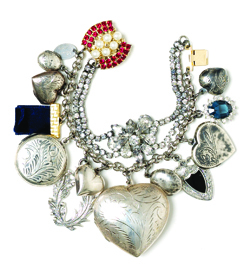
A charm bracelet is a type of bracelet which carries personal jewelled ornaments or "charms", such as decorative pendants or trinkets. The decorative charms usually carry personal or sentimental attachment by the owner.

Gel bracelets are a type of wristband often made from silicone.

A breast implant is a prosthesis used to change the size, shape, and contour of a person's breast. In reconstructive plastic surgery, breast implants can be placed to restore a natural looking breast following a mastectomy, to correct congenital defects and deformities of the chest wall or, cosmetically, to enlarge the appearance of the breast through breast augmentation surgery.
The MedicAlert Foundation is a non-profit company founded in 1956 and headquartered in Turlock, California. It maintains a database of members' medical information that is made available to medical authorities in the event of a medical emergency. Members supply critical medical data to the organization and receive a distinctive metal bracelet or necklace tag which is worn at all times. It can be used by first responders, such as emergency medical personnel or law-enforcement agents, to access wearers' medical history and special medical needs.

Artificial nails, also known as fake nails, false nails, acrylic nails, gel x nails, nail extensions or nail enhancements, are extensions placed over fingernails as fashion accessories. Many artificial nail designs attempt to mimic the appearance of real fingernails as closely as possible, while others may deliberately stray in favor of an artistic look.
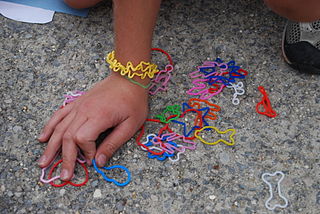
Silly Bandz are rubber bands made of silicone rubber formed into shapes including animals, objects, numbers, and letters. They are normally worn as bracelets. Silly Bandz retail in packages with select themes, such as princesses or animals, and fashion accessories. Similarly shaped silicone bands are also available under other brand names from a variety of companies. Silly Bandz were especially popular in the early 2010s.
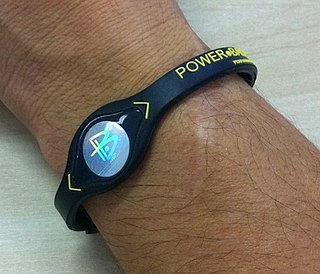
A hologram bracelet or energy bracelet is a small rubber wristband supposedly fitted with a hologram. Manufacturers have said that the holograms supposedly "optimise the natural flow of energy around the body," and, "improve an athlete's strength, balance and flexibility". Only anecdotal evidence supports these claims and tests performed by the Australian Skeptics, the University of Wales Institute, Cardiff, and the RMIT's School of Health Sciences have been unable to identify any effect on performance.
Reminderband Inc. is an American international company that manufactures and sells customized silicone wristbands and bracelets for multiple markets, including healthcare, entertainment/recreation, law enforcement, and more. With its headquarters in Logan, Utah, Reminderband also has a logistics and development center in Hong Kong.

Power Balance is the original brand of hologram bracelets claimed by its manufacturers and vendors to use "holographic technology" to "resonate with and respond to the natural energy field of the body" to increase athletic performance. Numerous independent studies of the device have found it to be no more effective than placebo for enhancing athletic performance. As a result, in 2010, the Australian distributor, Power Balance Australia Pty Ltd, was forced by the Australian Competition & Consumer Commission (ACCC) to retract any previous claims.
Barcode technology in healthcare is the use of optical machine-readable representation of data in a hospital or healthcare setting.

VITAband is a silicone encircling strip worn on the wrist. It can be referred to a bracelet-like band of a wristwatch, to the cuff or other part of a sleeve that covers the wrist. It is a lightweight, waterproof and hypoallergenic flexible wristband that is used when jogging, running, cycling or hiking, or when carrying a wallet is inconvenient. VITAband holds emergency medical information and Visa RFID credit card information. The wristband has two unique features. It comprises an integrated Visa Debit card with payWave wireless functionality and a toll-free phone number with unique identity code that can be used by EMTs to retrieve health information and contacts in case of an accident or health emergency.

The Xiaomi Mi Band is a wearable activity tracker produced by Xiaomi, unveiled during a Xiaomi launch event on 22 July 2014. This article is mainly about the original Mi Band; later versions have separate articles.
The salvation bracelet, also known as the gospel bracelet, witness bracelet, or wordless bracelet, is a bracelet used as a tool of Christian evangelism. The bracelet consists of a series of colored beads which represent key aspects of the Christian gospel.




